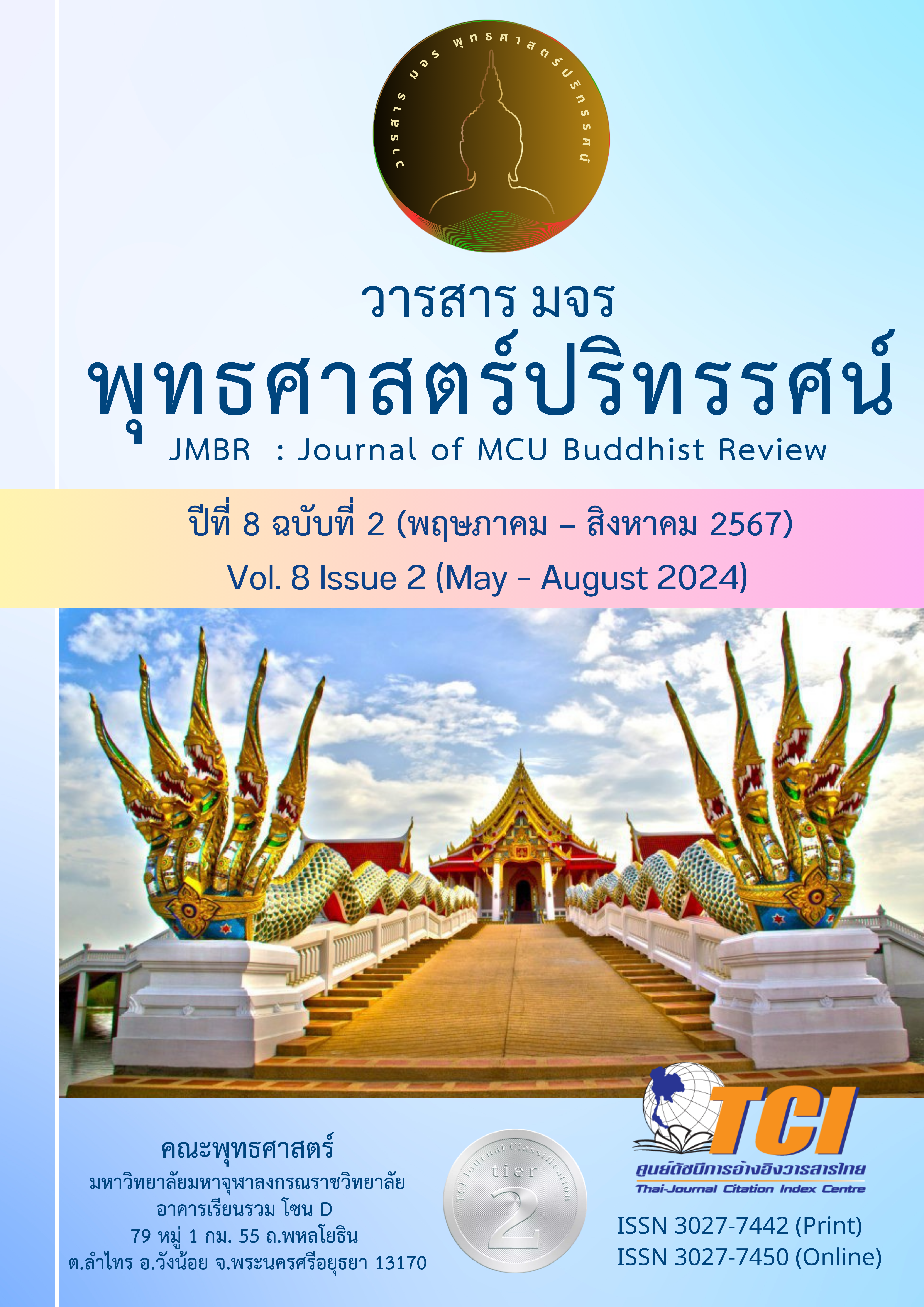สารัตถะของคำว่า “นโม” ในคัมภีร์พระพุทธศาสนาเถรวาท
Main Article Content
บทคัดย่อ
บทความวิจัยนี้มีวัตถุประสงค์เพื่อศึกษาการปรากฏและสาระสำคัญของคำว่า “นโม” ในคัมภีร์พระพุทธศาสนาเถรวาท ใช้ระเบียบวิธีวิจัยเอกสาร นำข้อมูลมาที่ได้มาวิเคราะห์เชิงเนื้อหาแล้วนำเสนอแบบพรรณนาวิเคราะห์
ผลการวิจัยพบว่า 1) คำว่า “นโม” ส่วนใหญ่ปรากฏในพระสุตตันตปิฎก พระวินัยปิฎกบางเล่ม อรรถกถาและฎีกาบางส่วน แต่ไม่ปรากฏในพระอภิธรรมปิฎก พบ 3 ลักษณะ คือ นโมที่ใช้คำเดียว นโมที่ใช้ร่วมกับกริยา และการใช้คำอื่นแทน นโมเป็นคำสามัญที่ใช้แสดงความนอบน้อมต่อบุคคลและสิ่งเคารพทั่วไป ไม่ใช่คำศักดิ์สิทธิ์ที่มีอำนาจเชิงบันดาล และไม่ได้ระบุว่าใครเป็นผู้กล่าวคนแรก 2) สาระสำคัญของคำว่า “นโม” พบ 9 เรื่อง ได้แก่ (1) ความหมายโดยตรงคือความนอบน้อม และความหมายเชิงขยายความคือการสักการะ เคารพ บูชา ไหว้ กราบ และนมัสการ (2) บุคคลและสิ่งอื่นที่มีผู้แสดงความนอบน้อมพบทั้งพระรัตนตรัย บุคคลทั่วไป เทวดา สัตว์ ปูชนียวัตถุ ปูชนียสถาน และธรรมชาติ (3) ธรรมเนียมการใช้นโม ถ้าเป็นบุคคล อมนุษย์ สัตว์ และสิ่งเคารพทั่วไปจะใช้ นโมคำเดียว นโมร่วมกับคำกริยา หรือคำอื่นแทน แต่ถ้าใช้กับพระพุทธเจ้า นอกจากจะใช้คำดังกล่าวแล้วยังใช้บทนมัสการ “นโม ตสฺส ภควโต อรหโต สมฺมาสมฺพุทฺธสฺส” 3 จบ (4) ลักษณะการใช้นโมพบ 2 ลักษณะคือใช้เป็นคำอุทานและแสดงความนอบน้อม (5) อิริยาบถพบทั้งอิริยาบถยืน เดิน นั่ง นอน (6) แรงจูงใจพบว่ามาจากความเลื่อมใส ความเชื่อ ความกลัว ความต้องการผลตอบแทน (7) วิธีปฏิบัติคือการห่มผ้าเฉวียงบ่า การคุกเข่า การทำอัญชลี วันทา อภิวาท และการกล่าวนโม (8) หลักธรรมที่สัมพันธ์กับนโม คืออปจายนธรรม การบูชา คารวธรรม และกรรม (9) ผลของการแสดงความนอบน้อมพบทั้งระดับโลกิยะ เช่น ทำให้เกิดปีติปราโมทย์ และผลในระดับ โลกุตตระคือ เป็นปัจจัยให้บรรลุมรรค ผล นิพพาน
Article Details

อนุญาตภายใต้เงื่อนไข Creative Commons Attribution-NonCommercial-NoDerivatives 4.0 International License.
- บทความที่ได้รับการตีพิมพ์เป็นลิขสิทธิ์ของวารสาร มจร พุทธศาสตร์ปริทรรศน์
- ข้อความใดๆ ที่ปรากฎในบทความที่ได้รับการตีพิมพ์ในวารสาร ถือเป็นความรับผิดชอบของผู้เขียนบทความ และข้อคิดเห็นนั้นไม่ถือว่าเป็นทัศนะและความรับผิดชอบของกองบรรณาธิการวารสาร มจร พุทธศาสตร์ปริทรรศน์
เอกสารอ้างอิง
ดิลก บุญอิ่ม. (2561). ความศรัทธาในพุทธมนต์ของชาวพุทธไทย. วารสารวิชาการธรรมทรรศน์. 18(20),269-279.
เทพย์ สาริกบุตร. (2538). คัมภีร์หัวใจ 108. กรุงเทพฯ: เสริมวิทย์บรรณาคาร.
ธีรโชติ เกิดแก้ว. (2552). ศึกษาวิเคราะห์สัญลักษณ์ทางพระพุทธศาสนาที่ปรากฏในยันต์ไทย. สมุทรปราการ: มหาวิทยาลัยหัวเฉียวเฉลิมพระเกียรติ.
ธีรปัญโญ. (2564). สวดมนต์: ต้นแบบชีวิตที่ประเสริฐ. วารสารโพธิยาลัย. 7(60), 42-52.
บุญส่ง สินธุ์นอก กฤติพิสิฐ จ่าพันธ์ และพระมหาศักดิ์ดา สิริเมธี (หารเทศ). (2561). ศึกษาวิเคราะห์การคารวะบูชาตามนัยพระไตรปิฎกในพระพุทธศาสนาเถรวาทพบ. วารสารปัญญาปณิธาน. 3(2), 58-68.
พระเทพพัชรญาณมุนี (ชยสาโร). (2564). พระเถระกล่าวถึงเรื่องการสวดมนต์. วารสารโพธิยาลัย. 7(60), 16-29.
พระมหามนตรี วลฺลโภ (ป้อมสุข). (2542). อิทธิพลของวัตถุมงคลที่มีต่อสังคมไทยในปัจจุบัน. วิทยานิพนธ์หลักสูตรพุทธศาสตรมหาบัณฑิต บัณฑิตวิทยาลัย: มหาวิทยาลัยมหาจุฬาลงกรณราชวิทยาลัย.
พระเมธีวชิรโสภณ (ประนอม ธมฺมาลงฺกาโร). (2564). เกร็ดความรู้เรื่องการสวดมนต์. วารสารโพธิยาลัย. 7(60), 1-11.
มหาจุฬาลงกรณราชวิทยาลัย. (2535). พระไตรปิฎกภาษาบาลี ฉบับมหาจุฬาเตปิฏกํ 2500. กรุงเทพฯ: การศาสนา.
มหาจุฬาลงกรณราชวิทยาลัย. (2539). พระไตรปิฎกภาษาไทย ฉบับมหาจุฬาลงกรณราชวิทยาลัย. กรุงเทพฯ: มหาจุฬาลงกรณราชวิทยาลัย.
มหาจุฬาลงกรณราชวิทยาลัย. (2532). อรรถกถาภาษาบาลี ฉบับมหาจุฬาอฏฺฐกถา. กรุงเทพฯ: วิญญาณ.
มหาจุฬาลงกรณราชวิทยาลัย. (2553). อรรถกถาภาษาไทย ฉบับมหาจุฬาลงกรณราชวิทยาลัย. กรุงเทพฯ: มหาจุฬาลงกรณราชวิทยาลัย.
มหาจุฬาลงกรณราชวิทยาลัย. (2539). ฎีกาษาบาลี ฉบับมหาจุฬาฏีกา. กรุงเทพฯ: วิญญาณ.
ราชบัณฑิตยสถาน. (2552). พจนานุกรมศัพทวรรณกรรมไทยฉบับราชบัณฑิตยสถาน 2552. กรุงเทพฯ: ราชบัณฑิตยสถาน.
วิโรจน์ คุ้มครอง, พระมหาวีรธิษณ์ วรินฺโท (อินทะโพธิ์) และคำพันธ์ วงศ์เสน่ห์. (2561). การวิเคราะห์ภาษาบาลีในภาษาไทย. นครปฐม: มหาวิทยาลัยมหาจุฬาลงกรณราชวิทยาลัย วิทยาเขตบาฬีศึกษาพุทธโฆส.


